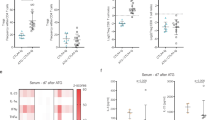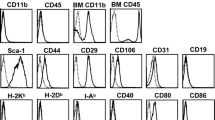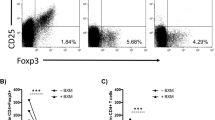Summary
The γc cytokines play an important role in proliferation and survival of T cells. Blocking the γc signals can cause the activated donor-reactive T cells losing the ability to proliferate, and getting into apoptosis pathway, which contributes to induction of the peripheral tolerance. In this study, we induced the transplant tolerance through blocking the γc in combination with donor-specific transfusion (DST) in the cardiac transplantation. Following DST, on the day 2, 4 and 6, C57BL/6 recipients received anti-γc monoclonal antibodies (mAbs) injection, and those in control group were not given anti-γc mAbs. On the day 7, Balb/c cardiac allografts were transplanted. All recipients in experimental group accepted cardiac allografts over 30 days, and two of them accepted allografts without rejection until sacrifice on the 120 day. Animals only receiving DST rejected grafts within 5 days, and the mice receiving cardiac transplantation alone rejected grafts within 9 days. Our study showed that blockade of γc signaling combined with DST significantly prolonged allograft survival, which was probably associated with inhibition of antigen-specific T-cell proliferation and induction of apoptosis.
Similar content being viewed by others
References
Tyznik AJ, Bevan MJ. The surprising kinetics of the T cell response to live antigenic cells. J Immunol, 2007,179(8): 4988–4995
Carlens J, Wahl B, Ballmaier M, et al. Common gamma-chain-dependent signals confer selective survival of eosinophils in the murine small intestine. J Immunol, 2009,183(9):5600–5607
Overwijk WW, Schluns KS. Functions of gammaC cytokines in immune homeostasis: current and potential clinical applications. Clin Immunol, 2009,132(2):153–165
Amorosi S, Russo I, Amodio G, et al. The cellular amount of the common gamma-chain influences spontaneous or induced cell proliferation. J Immunol, 2009,182(5):3304–3309
Lenardo M, Chan KM, Hornung F, et al. Mature T lymphocyte apoptosis-immune regulation in a dynamic and unpredictable antigenic environment. Annu Rev Immunol, 1999, 17:221–253
Ramsey C, Rubinstein MP, Kim DM, et al. The lymphopenic environment of CD132 (common gamma-chain)-deficient hosts elicits rapid homeostatic proliferation of naive T cells via IL-15. J Immunol, 2008,180(8): 5320–5326
Hayashi Y, Yamazaki S, Kanamoto A, et al. Splenocytes can replace chimeric cells and maintain allograft tolerance. Transplantation, 2007, 84(9):1168–1173
Abe Y, Urakami H, Ostanin D, et al. Induction of Foxp3-expressing regulatory T-cells by donor blood transfusion is required for tolerance to rat liver allografts. PLoS One, 2009,4(11):e7840
Kishimoto K, Yuan X, Auchincloss H Jr, et al. Mechanism of action of donor-specific transfusion in inducing tolerance: role of donor MHC molecules, donor co-stimulatory molecules, and indirect antigen presentation. J Am Soc Nephrol, 2004,15(9):2423–2428
Gao D, Lunsford KE, Eiring AM, et al. Critical role for CD8 T cells in allograft acceptance induced by DST and CD40/CD154 costimulatory blockade. Am J Transplant, 2004,4(7):1061–1070
Chen ZH. A technique of cervical heterotopic heart transplantation in mice. Transplantation, 1991,52(6):1099–1101
Gregori S, Bacchetta R, Passerini L, et al. Isolation, expansion, and characterization of human natural and adaptive regulatory T cells. Methods Mol Biol, 2007,380: 83–105
Riou C, Dumont AR, Yassine-Diab B, et al. IL-4 influences the differentiation and the susceptibility to activation-induced cell death of human naive CD8+ T cells. Int Immunol, 2006,18(6):827–835
Shi M, Lin TH, Appell KC, et al. Cell cycle progression following naive T cell activation is independent of Jak3/common gamma-chain cytokine signals. J Immunol, 2009,183(7):4493–4501
Blossom SJ, Pumford NR, Gilbert KM. Activation and attenuation of apoptosis of CD4+ T cells following in vivo exposure to two common environmental toxicants, trichloroacetaldehyde hydrate and trichloroacetic acid. J Autoimmun, 2004,23(3):211–220
Surh CD, Sprent J. Regulation of mature T cell homeostasis. Semin Immunol, 2005,17(3):183–191
Dunlop MB, Doherty PC, Zinkernagel RM, et al. Secondary cytotoxic cell response to lymphocytic choriomeningitis virus II. Nature and specificity of effector cells. Immunology, 1976,31(2):181–186
Author information
Authors and Affiliations
Corresponding author
Additional information
This project was supported by grants from the National Natural Sciences Foundation of China (No. 30500468 and 30700768).
Rights and permissions
About this article
Cite this article
Chang, S., Wang, L., Lin, X. et al. Blockade of γc signals in combination with donor-specific transfusion induces cardiac allograft acceptance in murine models. J. Huazhong Univ. Sci. Technol. [Med. Sci.] 30, 421–424 (2010). https://doi.org/10.1007/s11596-010-0442-4
Received:
Published:
Issue Date:
DOI: https://doi.org/10.1007/s11596-010-0442-4




